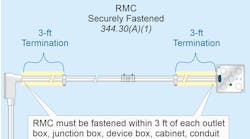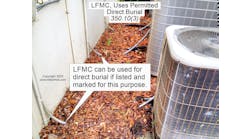Q. Since the electric utility power meter has the neutral bonded to the enclosure, is it necessary to install a main bonding jumper in the service disconnect?
A. Yes, a service neutral conductor from the electric utility must be routed with the ungrounded conductors and terminate to the service disconnecting means via a main bonding jumper [250.24(B) and 250.28], as shown in the Figure. The service neutral conductor provides the effective ground-fault current path to the power supply to ensure that dangerous voltage from a ground fault will be quickly removed by opening the overcurrent device [250.4(A)(3) and 250.4(A)(5)].
Caution: Dangerous voltage from a ground fault won’t be removed from metal parts, metal piping, and structural steel if the service disconnecting means enclosure isn’t connected to the service neutral conductor. This is because the contact resistance of a grounding electrode to the earth is so great that insufficient fault current returns to the power supply if the earth is the only fault current return path to open the circuit overcurrent device.
Q. What are the NEC requirements when replacing 2-wire receptacles in bathrooms where there is no equipment grounding conductor in the outlet box?
A. When existing receptacles are replaced in locations where GFCI protection is currently required, the replacement receptacles must be GFCI protected. This includes the replacement of receptacles in dwelling unit bathrooms, garages, outdoors, crawl spaces, unfinished basements, kitchen countertops, rooftops, or within 6 ft of laundry, utility, and wet bar sinks [406.3(D)(2)].
If no equipment grounding conductor exists in the outlet box for the receptacle, such as old 2-wire Type NM cable without an equipment grounding conductor, existing nongrounding-type receptacles can be replaced with [406.3(D)(3)]:
- A GFCI-type receptacle marked “No Equipment Ground,” or
- A grounding-type receptacle, if GFCI protected and marked “GFCI Protected” and “No Equipment Ground.”
GFCI protection functions properly on a 2-wire circuit without an equipment grounding conductor because the circuit equipment grounding conductor serves no role in the operation of the GFCI-protection device.
Q. Is a hard-wired 120V rated electric heater in a bathroom required to be GFCI protected?
A. No. GFCI protection is only required for 15A and 20A, 125V receptacles located in the bathroom area of a dwelling unit [210.8(A)].
Q. What are the installation requirements for installing nonconductive fiber-optic cable in the same raceway with power conductors?
A. Nonconductive optical fiber cables are permitted to occupy the same cable tray or raceway with conductors for electric light, power, and Class 1 circuits [770.133(A)]. Nonconductive optical fiber cables can’t occupy a cabinet, outlet box, panel, or similar enclosure housing the electrical terminations of an electric light, power, or Class 1 circuit.
Ex 1: Nonconductive optical fiber cables are permitted to occupy the same cabinet, outlet box, panel, or similar enclosure housing the electrical terminations of an electric light, power, or Class 1 circuit, if the nonconductive optical fiber cable is functionally associated with the electric light, power, or Class 1 circuit.
Q. Is it always necessary to install equipment grounding conductors in each parallel feeder from a generator to the transfer switch?
A. If circuit conductors are installed in parallel in separate raceways as permitted by 310.4, then an equipment grounding conductor must be installed for each parallel conductor set. Where conductors are installed in parallel in the same raceway or cable tray, a single equipment grounding conductor is permitted [250.122(F)]. Each equipment grounding conductor must be sized in accordance with Table 250.122, based on the rating of the circuit overcurrent device, but it’s not required to be larger than the circuit conductors [250.122(A)].
Q. Can a receptacle outlet be installed above a suspended ceiling to feed cord-connected equipment, such as a projector, by feeding the cord through the ceiling?
A. No. Flexible cords must not be run through holes in walls, structural ceilings, suspended or dropped ceilings, or floors [400.8(2)].




